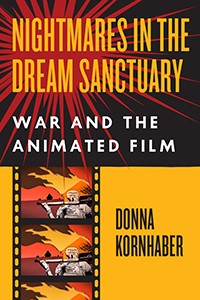There is no doubt that Donna Kornhaber is an expert in wartime animation. In her new book, Nightmares in the Dream Sanctuary: War and the Animated Film, she broadens the field’s critical landscape by looking beyond the propaganda shorts of Walt Disney and World War II. Kornhaber instead shines light on animators personally affected by genocide and occupation. Her many examples – from Chile, Kenya, South Korea, and elsewhere – are less concerned with fact and ideology than personal experience. These films are studies in trauma informed by their creators’ histories. In short, they are marked by their propensities to bear witness. Using Walter Benjamin and Julia Kristeva, among others, Kornhaber positions animation as the medium best able to depict the upheaval of war and its impact on the individual in the 20th century. The form’s inherent plasticity and disregard for time and space are suited to the discord and unreality of combat. As Kornhaber asks, “is there an art form better suited than animation to this incomprehensible place of perpetual transformation that is the interior world of war?”1
Nightmares in the Dream Sanctuary is split into two sections. The first, “At War,” examines what Kornhaber calls the “Resistance Film” and the “Pacifist Film.” Resistance films are created by those whose nations are occupied or under siege. Such animations “always speak in a double voice:” to those in power they must be innocuous cartoons and to those being victimized they must function as beacons of hope.2 Paul Grimault’s The Scarecrow (1943), for instance, may seem like the story of an apolitical straw-man, however, under the surface, the film bravely employs its eponymous hero to envision a France free of Nazi rule. It is the resistance animator’s job to weaponize their experiences and to take apart the dominant power structure. Pacifist films, on the other hand, take no sides. As Kornhaber insists, they are “a universal and total denunciation of the conflict itself.”3 Through a number of animations, styles, and characters – including anthropomorphic Yemeni chess pieces and Felix the Cat – Kornhaber traces the anti-war efforts of directors intent on emphasizing the inanity of violence.
In her book’s first half, Kornhaber close-reads dozens of films in very similar ways. She recounts the personal history of the animator, the larger history of trauma they are representing, and then the film itself: first its surface narrative and then its embedded one – what James Scott calls the hidden transcript. Though each analysis is worthwhile, their aggregate begins to take on a predictable rhythm. Of note, however, is her discussion of Czech filmmaker Jiří Trnka’s The Hand (1965), “perhaps the single most renowned work of resistance animation ever put to film.”4 The stop-motion short, in which a freedom-fighting sculptor is imprisoned by a dictator, signals both the power and danger of resistance and pacifist filmmaking. While devoting one’s life to fighting hate can literally liberate the animator, it also denies them artistic freedom. A film rebelling against dictatorship is still about that very dictatorship. As Kornhaber puts it, “to work at the level of the symbol is to put oneself in thrall to the state whether one knows it or not.”5 How, then, can one bear witness without centralizing violence or the oppressor? In the second half of her book, Kornhaber begins to answer this question.
The latter part of Nightmares in the Dream Sanctuary, “After War,” discusses the “Memory Film” and the “Memorial Film.” Opposing the book’s first section, these animations are less indictments of war than ways to remember them. Memory films, for instance, attempt to understand the directors’ experience. The movies discussed are “not so much a presentation of memory as a grappling with it.”6 Kornhaber’s many examples, among them Persepolis (2007) and Waltz with Bashir (2008), re-enforce her belief in wartime animation’s inherent discontinuity. Such films use their medium-specific qualities to create stories as strange and fragmented as the conflicts they represent. As Kornhaber writes, the memory film emphasizes “the ultimate inadequacy of any narrative to fully capture the uncapturable experience of war.”7
Where the Memory film revels in abstraction, Memorial animation attempts to record wartime experience. Their creators are less recounting their own lives than memorializing events larger than their personal histories. Here, Kornhaber discusses the problematics of bearing witness to occurrences beyond one’s purview. There is a constant struggle in Memorial films between depicting first-person accounts and recognizing the limits of the third-person witness. Kornhaber explores this double bind through a number of films, most noteworthy those depicting two of the 20th century’s most infamous events: The Holocaust and the bombings of Japan. Closing her book with a reading of Grave of Fireflies (1988), a wrenching anime depicting the firebombing of Kobe, Kornhaber demonstrates that, ultimately, the Memorial film must expose trauma in order to inform its audience.
What Nightmares in the Dream Sanctuary does best is weave together its many examples. Kornhaber unites dozens of films through a careful attention to thematic continuity. Her Resistance films, for instance, each demonstrate similar goals of dissidence and subversion. The problem with such taxonomy, however, is that it often feels forced and reverse engineered. While Kornhaber’s writing is beautiful, I could not help but feel as if movies like The Hand could be pigeonholed into any of her four categories. This, alongside a lack of theory and recourse to plot description, resulted in an unintentional homogeny. Still, as a first step in chronicling outlying wartime animation, Nightmares in the Dream Sanctuary is a success. Kornhaber’s newest book acts as a sort of encyclopedia of off-the-beaten path films – a reference book for beginner animation scholars. As she writes in her final chapter, “The story must be told.”8
Author Biography:
Josh Heaps is a film scholar and doctoral student at the University of North Carolina at Chapel Hill. While his current research surveys truth, form, and genre in experimental and documentary cinema, he maintains a strong interest in camp, cult, and horror.


